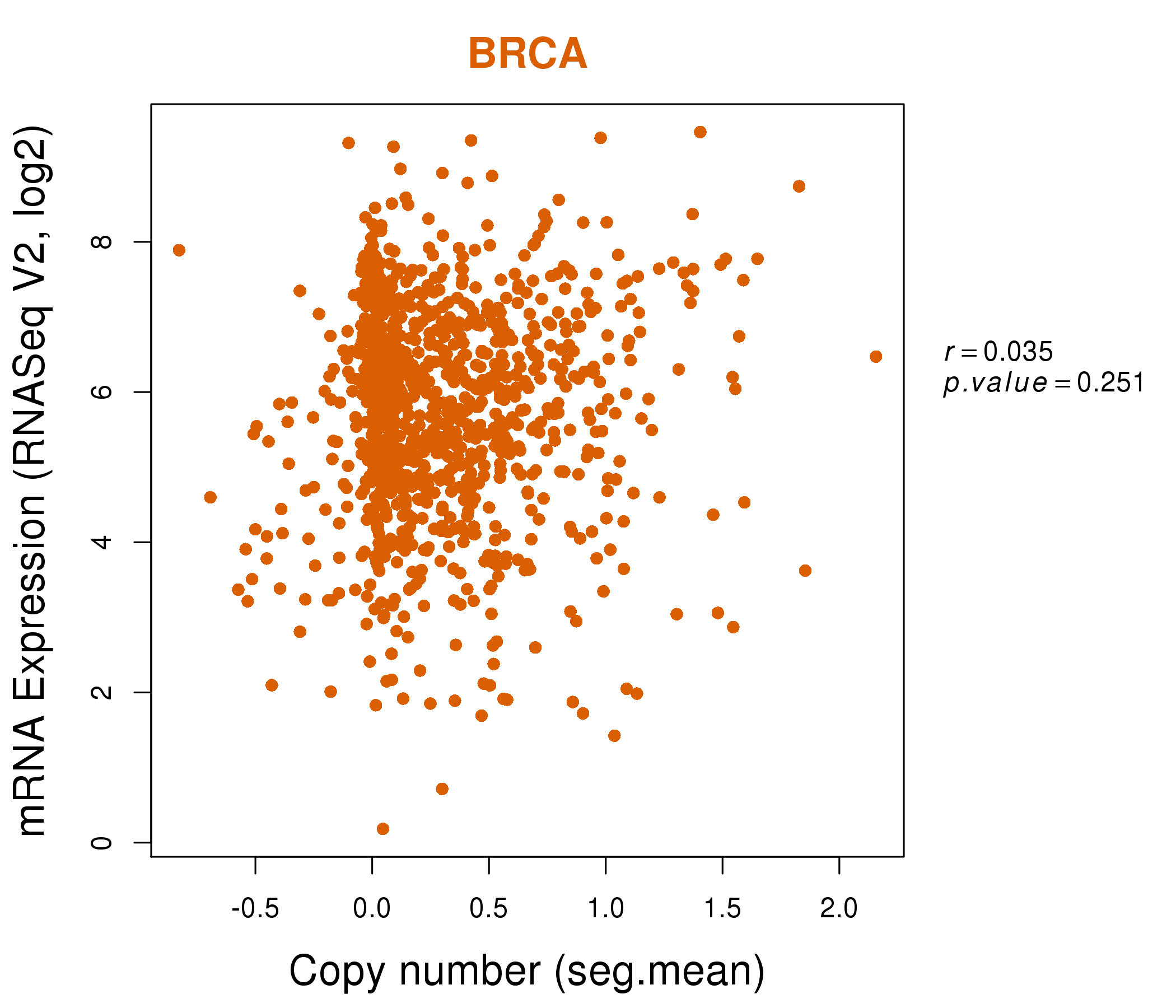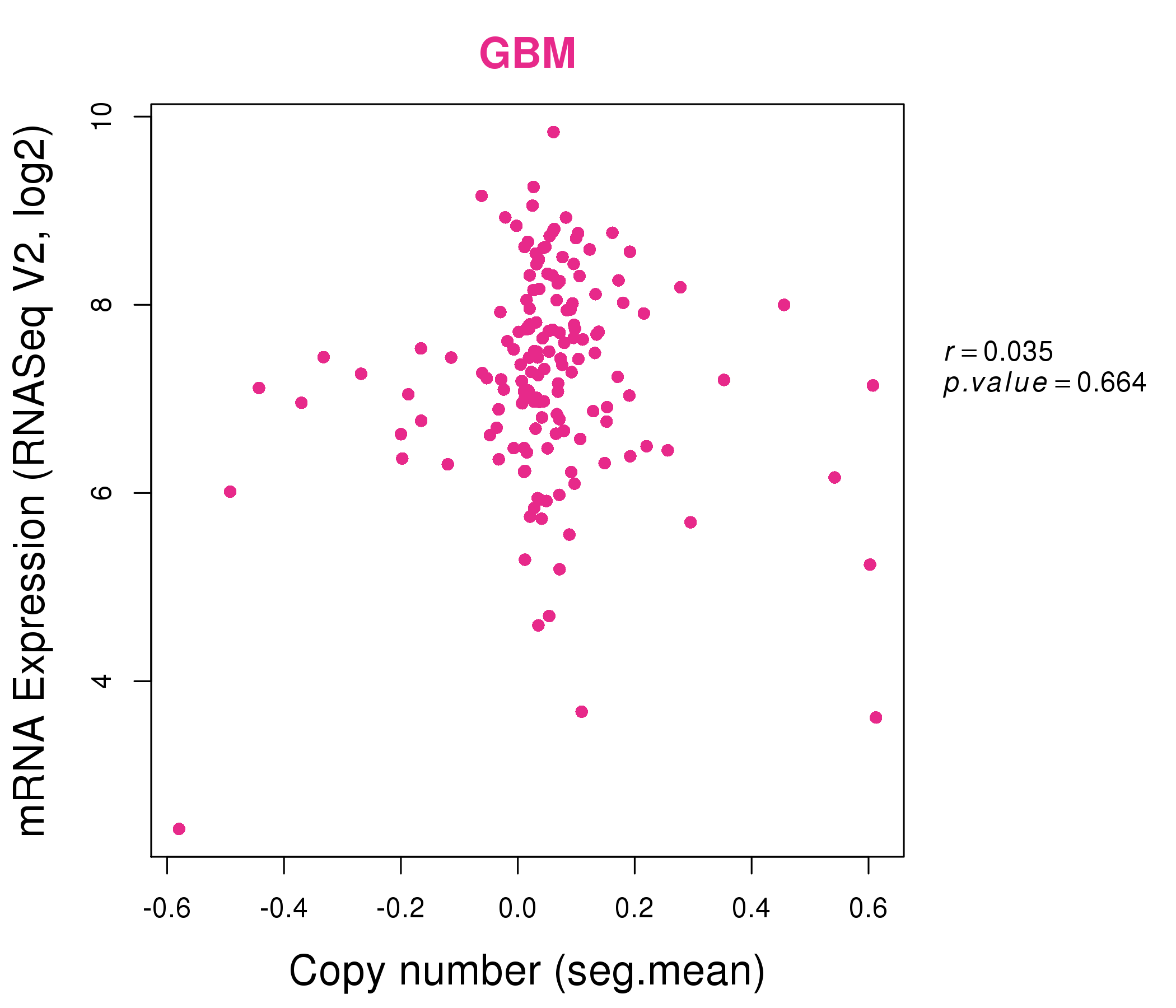|
||||||||||||||||||||||||||||||||||||||||||||||||||||||||||||||||||||||||||||||||||||||||||||||||||||||||||||||||||||||||||||||||||||||||||||||||||||||||||||||||||||||||||||||||||||||||||||||||||||||||||||||||||||||||||||||||||||||||||||||||||||||||||||||||||||||||||||||||||||||||||||||||||||||||||||||||||||||||||
| |
| Phenotypic Information (metabolism pathway, cancer, disease, phenome) |
| |
| |
| Gene-Gene Network Information: Co-Expression Network, Interacting Genes & KEGG |
| |
|
| Gene Summary for ADHFE1 |
| Basic gene info. | Gene symbol | ADHFE1 |
| Gene name | alcohol dehydrogenase, iron containing, 1 | |
| Synonyms | ADH8|HOT | |
| Cytomap | UCSC genome browser: 8q13.1 | |
| Genomic location | chr8 :67344717-67381044 | |
| Type of gene | protein-coding | |
| RefGenes | NM_144650.2, | |
| Ensembl id | ENSG00000147576 | |
| Description | Fe-containing alcohol dehydrogenase 1alcohol dehydrogenase 8alcohol dehydrogenase iron-containing protein 1hydroxyacid-oxoacid transhydrogenase, mitochondrial | |
| Modification date | 20141222 | |
| dbXrefs | MIM : 611083 | |
| HGNC : HGNC | ||
| Ensembl : ENSG00000147576 | ||
| HPRD : 12428 | ||
| Vega : OTTHUMG00000150215 | ||
| Protein | UniProt: go to UniProt's Cross Reference DB Table | |
| Expression | CleanEX: HS_ADHFE1 | |
| BioGPS: 137872 | ||
| Gene Expression Atlas: ENSG00000147576 | ||
| The Human Protein Atlas: ENSG00000147576 | ||
| Pathway | NCI Pathway Interaction Database: ADHFE1 | |
| KEGG: ADHFE1 | ||
| REACTOME: ADHFE1 | ||
| ConsensusPathDB | ||
| Pathway Commons: ADHFE1 | ||
| Metabolism | MetaCyc: ADHFE1 | |
| HUMANCyc: ADHFE1 | ||
| Regulation | Ensembl's Regulation: ENSG00000147576 | |
| miRBase: chr8 :67,344,717-67,381,044 | ||
| TargetScan: NM_144650 | ||
| cisRED: ENSG00000147576 | ||
| Context | iHOP: ADHFE1 | |
| cancer metabolism search in PubMed: ADHFE1 | ||
| UCL Cancer Institute: ADHFE1 | ||
| Assigned class in ccmGDB | C | |
| Top |
| Phenotypic Information for ADHFE1(metabolism pathway, cancer, disease, phenome) |
| Cancer | CGAP: ADHFE1 |
| Familial Cancer Database: ADHFE1 | |
| * This gene is included in those cancer gene databases. |
|
|
|
|
|
| . | ||||||||||||||||||||||||||||||||||||||||||||||||||||||||||||||||||||||||||||||||||||||||||||||||||||||||||||||||||||||||||||||||||||||||||||||||||||||||||||||||||||||||||||||||||||||||||||||||||||||||||||||||||||||||||||||||||||||||||||||||||||||||||||||||||||||||||||||||||||||||||||||||||||||||||||||||||||
Oncogene 1 | Significant driver gene in | |||||||||||||||||||||||||||||||||||||||||||||||||||||||||||||||||||||||||||||||||||||||||||||||||||||||||||||||||||||||||||||||||||||||||||||||||||||||||||||||||||||||||||||||||||||||||||||||||||||||||||||||||||||||||||||||||||||||||||||||||||||||||||||||||||||||||||||||||||||||||||||||||||||||||||||||||||||||||
| cf) number; DB name 1 Oncogene; http://nar.oxfordjournals.org/content/35/suppl_1/D721.long, 2 Tumor Suppressor gene; https://bioinfo.uth.edu/TSGene/, 3 Cancer Gene Census; http://www.nature.com/nrc/journal/v4/n3/abs/nrc1299.html, 4 CancerGenes; http://nar.oxfordjournals.org/content/35/suppl_1/D721.long, 5 Network of Cancer Gene; http://ncg.kcl.ac.uk/index.php, 1Therapeutic Vulnerabilities in Cancer; http://cbio.mskcc.org/cancergenomics/statius/ |
| REACTOME_PYRUVATE_METABOLISM_AND_CITRIC_ACID_TCA_CYCLE | |
| OMIM | |
| Orphanet | |
| Disease | KEGG Disease: ADHFE1 |
| MedGen: ADHFE1 (Human Medical Genetics with Condition) | |
| ClinVar: ADHFE1 | |
| Phenotype | MGI: ADHFE1 (International Mouse Phenotyping Consortium) |
| PhenomicDB: ADHFE1 | |
| Mutations for ADHFE1 |
| * Under tables are showing count per each tissue to give us broad intuition about tissue specific mutation patterns.You can go to the detailed page for each mutation database's web site. |
| - Statistics for Tissue and Mutation type | Top |
 |
| - For Inter-chromosomal Variations |
| There's no inter-chromosomal structural variation. |
| - For Intra-chromosomal Variations |
| * Intra-chromosomal variantions includes 'intrachromosomal amplicon to amplicon', 'intrachromosomal amplicon to non-amplified dna', 'intrachromosomal deletion', 'intrachromosomal fold-back inversion', 'intrachromosomal inversion', 'intrachromosomal tandem duplication', 'Intrachromosomal unknown type', 'intrachromosomal with inverted orientation', 'intrachromosomal with non-inverted orientation'. |
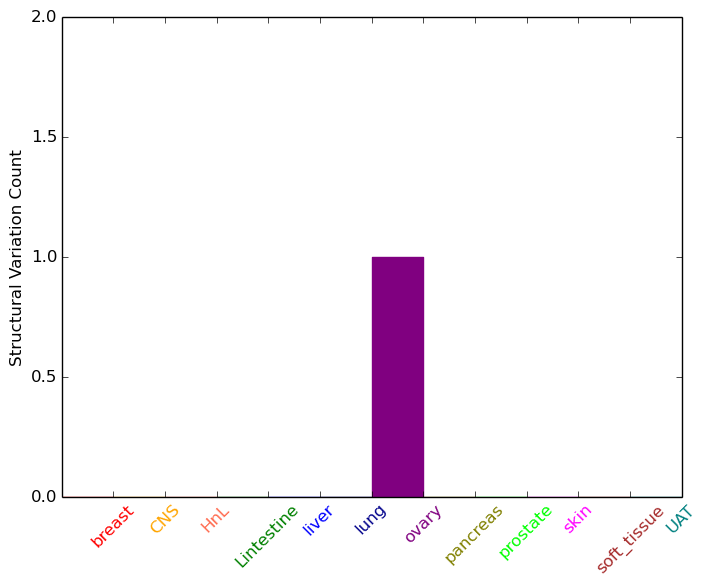 |
| Sample | Symbol_a | Chr_a | Start_a | End_a | Symbol_b | Chr_b | Start_b | End_b |
| ovary | ADHFE1 | chr8 | 67358841 | 67358861 | ADHFE1 | chr8 | 67360617 | 67360637 |
| cf) Tissue number; Tissue name (1;Breast, 2;Central_nervous_system, 3;Haematopoietic_and_lymphoid_tissue, 4;Large_intestine, 5;Liver, 6;Lung, 7;Ovary, 8;Pancreas, 9;Prostate, 10;Skin, 11;Soft_tissue, 12;Upper_aerodigestive_tract) |
| * From mRNA Sanger sequences, Chitars2.0 arranged chimeric transcripts. This table shows ADHFE1 related fusion information. |
| ID | Head Gene | Tail Gene | Accession | Gene_a | qStart_a | qEnd_a | Chromosome_a | tStart_a | tEnd_a | Gene_a | qStart_a | qEnd_a | Chromosome_a | tStart_a | tEnd_a |
| Top |
| Mutation type/ Tissue ID | brca | cns | cerv | endome | haematopo | kidn | Lintest | liver | lung | ns | ovary | pancre | prost | skin | stoma | thyro | urina | |||
| Total # sample | 1 | 1 | ||||||||||||||||||
| GAIN (# sample) | 1 | |||||||||||||||||||
| LOSS (# sample) | 1 |
| cf) Tissue ID; Tissue type (1; Breast, 2; Central_nervous_system, 3; Cervix, 4; Endometrium, 5; Haematopoietic_and_lymphoid_tissue, 6; Kidney, 7; Large_intestine, 8; Liver, 9; Lung, 10; NS, 11; Ovary, 12; Pancreas, 13; Prostate, 14; Skin, 15; Stomach, 16; Thyroid, 17; Urinary_tract) |
| Top |
|
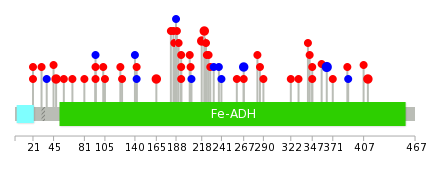 |
| Top |
| Stat. for Non-Synonymous SNVs (# total SNVs=34) | (# total SNVs=12) |
 | 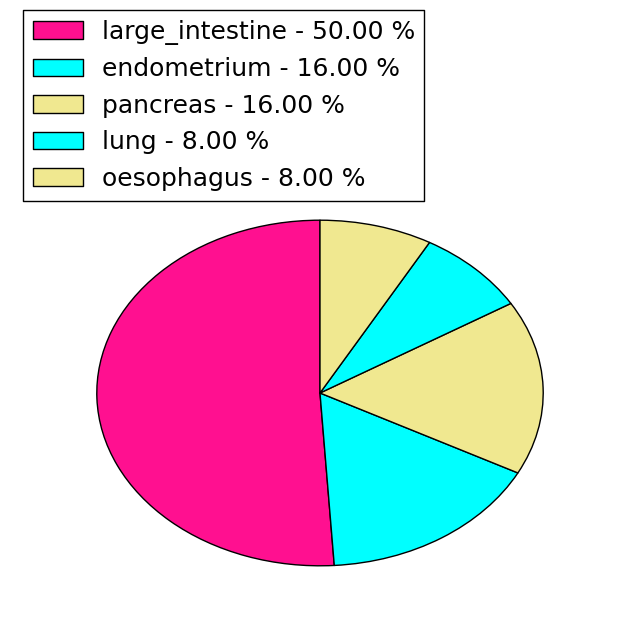 |
(# total SNVs=1) | (# total SNVs=0) |
 |
| Top |
| * When you move the cursor on each content, you can see more deailed mutation information on the Tooltip. Those are primary_site,primary_histology,mutation(aa),pubmedID. |
| GRCh37 position | Mutation(aa) | Unique sampleID count |
| chr8:67372616-67372616 | p.F364F | 3 |
| chr8:67364258-67364258 | p.R221W | 2 |
| chr8:67356917-67356917 | p.S48F | 2 |
| chr8:67361196-67361196 | p.D194G | 2 |
| chr8:67361109-67361109 | p.S165L | 2 |
| chr8:67356836-67356836 | p.K21R | 2 |
| chr8:67364250-67364250 | p.P218L | 2 |
| chr8:67366351-67366351 | p.A267A | 2 |
| chr8:67361171-67361171 | p.R186* | 2 |
| chr8:67356867-67356867 | p.M31I | 1 |
| Top |
|
 |
| Point Mutation/ Tissue ID | 1 | 2 | 3 | 4 | 5 | 6 | 7 | 8 | 9 | 10 | 11 | 12 | 13 | 14 | 15 | 16 | 17 | 18 | 19 | 20 |
| # sample | 2 | 1 | 13 | 2 | 1 | 1 | 4 | 2 | 1 | 4 | 7 | 4 | ||||||||
| # mutation | 2 | 1 | 12 | 2 | 1 | 1 | 8 | 2 | 1 | 4 | 8 | 6 | ||||||||
| nonsynonymous SNV | 2 | 1 | 8 | 2 | 1 | 1 | 4 | 2 | 1 | 4 | 6 | 4 | ||||||||
| synonymous SNV | 4 | 4 | 2 | 2 |
| cf) Tissue ID; Tissue type (1; BLCA[Bladder Urothelial Carcinoma], 2; BRCA[Breast invasive carcinoma], 3; CESC[Cervical squamous cell carcinoma and endocervical adenocarcinoma], 4; COAD[Colon adenocarcinoma], 5; GBM[Glioblastoma multiforme], 6; Glioma Low Grade, 7; HNSC[Head and Neck squamous cell carcinoma], 8; KICH[Kidney Chromophobe], 9; KIRC[Kidney renal clear cell carcinoma], 10; KIRP[Kidney renal papillary cell carcinoma], 11; LAML[Acute Myeloid Leukemia], 12; LUAD[Lung adenocarcinoma], 13; LUSC[Lung squamous cell carcinoma], 14; OV[Ovarian serous cystadenocarcinoma ], 15; PAAD[Pancreatic adenocarcinoma], 16; PRAD[Prostate adenocarcinoma], 17; SKCM[Skin Cutaneous Melanoma], 18:STAD[Stomach adenocarcinoma], 19:THCA[Thyroid carcinoma], 20:UCEC[Uterine Corpus Endometrial Carcinoma]) |
| Top |
| * We represented just top 10 SNVs. When you move the cursor on each content, you can see more deailed mutation information on the Tooltip. Those are primary_site, primary_histology, mutation(aa), pubmedID. |
| Genomic Position | Mutation(aa) | Unique sampleID count |
| chr8:67372616 | p.F412F | 3 |
| chr8:67361186 | p.R392H | 2 |
| chr8:67372555 | p.S239R | 2 |
| chr8:67366351 | p.A315A | 2 |
| chr8:67355077 | p.S96F | 1 |
| chr8:67369056 | p.S213L | 1 |
| chr8:67357524 | p.G338V | 1 |
| chr8:67372645 | p.L97I | 1 |
| chr8:67361172 | p.P218P | 1 |
| chr8:67356836 | p.L359L | 1 |
| * Copy number data were extracted from TCGA using R package TCGA-Assembler. The URLs of all public data files on TCGA DCC data server were gathered on Jan-05-2015. Function ProcessCNAData in TCGA-Assembler package was used to obtain gene-level copy number value which is calculated as the average copy number of the genomic region of a gene. |
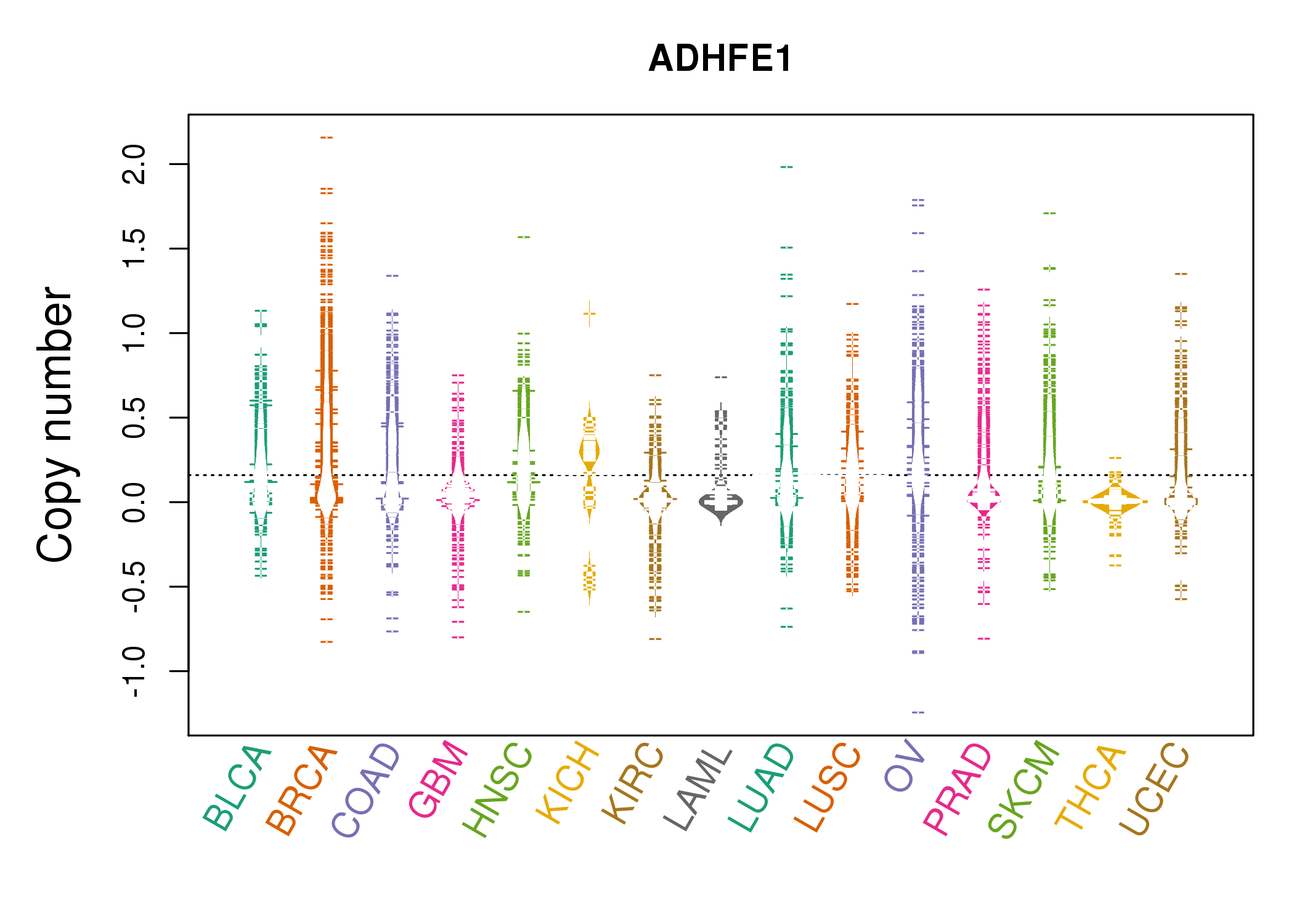 |
| cf) Tissue ID[Tissue type]: BLCA[Bladder Urothelial Carcinoma], BRCA[Breast invasive carcinoma], CESC[Cervical squamous cell carcinoma and endocervical adenocarcinoma], COAD[Colon adenocarcinoma], GBM[Glioblastoma multiforme], Glioma Low Grade, HNSC[Head and Neck squamous cell carcinoma], KICH[Kidney Chromophobe], KIRC[Kidney renal clear cell carcinoma], KIRP[Kidney renal papillary cell carcinoma], LAML[Acute Myeloid Leukemia], LUAD[Lung adenocarcinoma], LUSC[Lung squamous cell carcinoma], OV[Ovarian serous cystadenocarcinoma ], PAAD[Pancreatic adenocarcinoma], PRAD[Prostate adenocarcinoma], SKCM[Skin Cutaneous Melanoma], STAD[Stomach adenocarcinoma], THCA[Thyroid carcinoma], UCEC[Uterine Corpus Endometrial Carcinoma] |
| Top |
| Gene Expression for ADHFE1 |
| * CCLE gene expression data were extracted from CCLE_Expression_Entrez_2012-10-18.res: Gene-centric RMA-normalized mRNA expression data. |
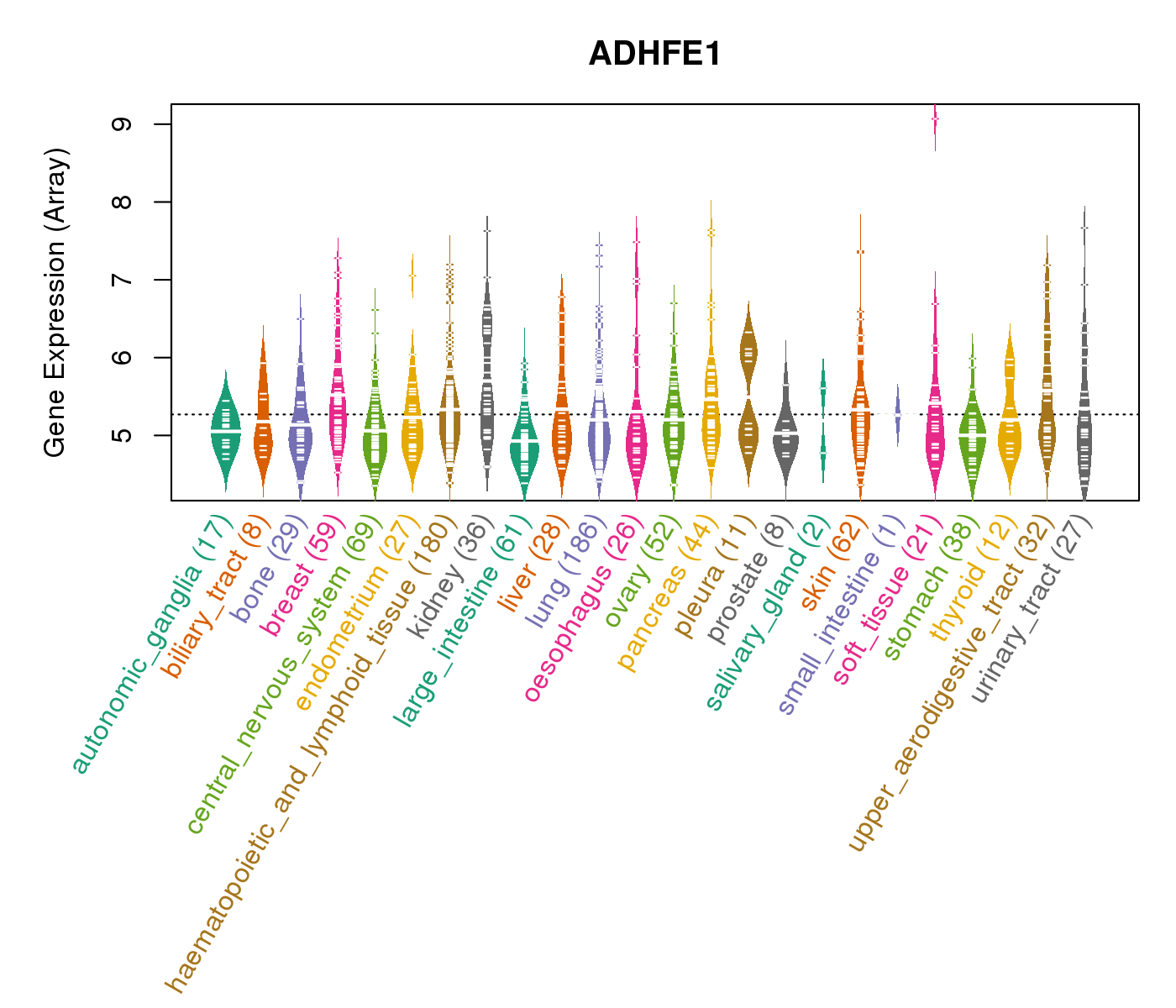 |
| * Normalized gene expression data of RNASeqV2 was extracted from TCGA using R package TCGA-Assembler. The URLs of all public data files on TCGA DCC data server were gathered at Jan-05-2015. Only eight cancer types have enough normal control samples for differential expression analysis. (t test, adjusted p<0.05 (using Benjamini-Hochberg FDR)) |
 |
| Top |
| * This plots show the correlation between CNV and gene expression. |
: Open all plots for all cancer types
 |
|
 |
|
| Top |
| Gene-Gene Network Information |
| * Co-Expression network figures were drawn using R package igraph. Only the top 20 genes with the highest correlations were shown. Red circle: input gene, orange circle: cell metabolism gene, sky circle: other gene |
: Open all plots for all cancer types
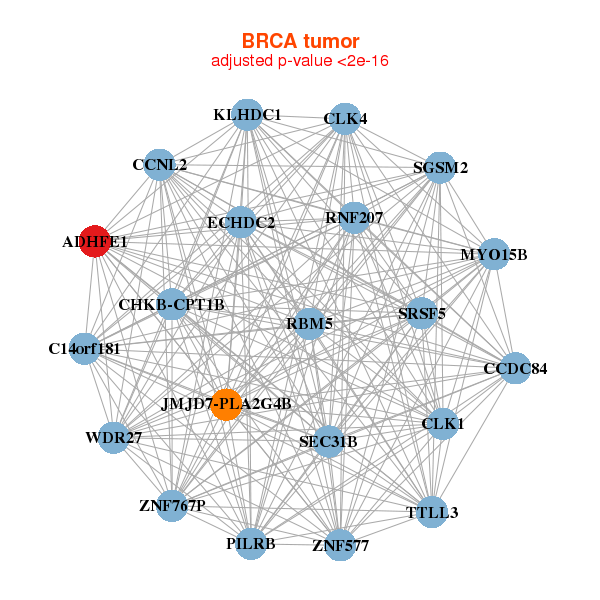 |
|
| ADHFE1,C14orf181,CCDC84,CCNL2,CHKB-CPT1B,CLK1,CLK4, ECHDC2,JMJD7-PLA2G4B,KLHDC1,MYO15B,PILRB,RBM5,RNF207, SEC31B,SRSF5,SGSM2,TTLL3,WDR27,ZNF577,ZNF767P | ACAT1,ADHFE1,ATPAF1,CS,DLD,DLST,ETFA, ETFDH,GPT2,HSDL2,KIAA0408,PDHA1,PDK2,PFKFB1, PHYH,PLIN5,PPARA,RNF157,SLC2A4,STRADB,SUCLA2 |
 |
|
| ADAM33,ADHFE1,ANK2,AOC3,ASB2,ATP1A2,CBX7, CCDC69,FHL1,FNBP1,GNAO1,GPRASP1,LOC728264,MAPK10, MYOM1,NAP1L2,NEGR1,PDE2A,RIC3,SDPR,SLC9A9 | ADAMTS10,ADHFE1,C10orf25,C11orf63,C1orf56,CAPRIN2,DFNB59, GTF2IRD2P1,LOC100271722,LOC388387,LRRC2,PTH1R,SATB1,SGSM2, SIX5,TJAP1,TMEM136,TRIM45,VEGFB,ZNF337,ZNF444 |
| * Co-Expression network figures were drawn using R package igraph. Only the top 20 genes with the highest correlations were shown. Red circle: input gene, orange circle: cell metabolism gene, sky circle: other gene |
: Open all plots for all cancer types
| Top |
: Open all interacting genes' information including KEGG pathway for all interacting genes from DAVID
| Top |
| Pharmacological Information for ADHFE1 |
| There's no related Drug. |
| Top |
| Cross referenced IDs for ADHFE1 |
| * We obtained these cross-references from Uniprot database. It covers 150 different DBs, 18 categories. http://www.uniprot.org/help/cross_references_section |
: Open all cross reference information
|
Copyright © 2016-Present - The Univsersity of Texas Health Science Center at Houston @ |






